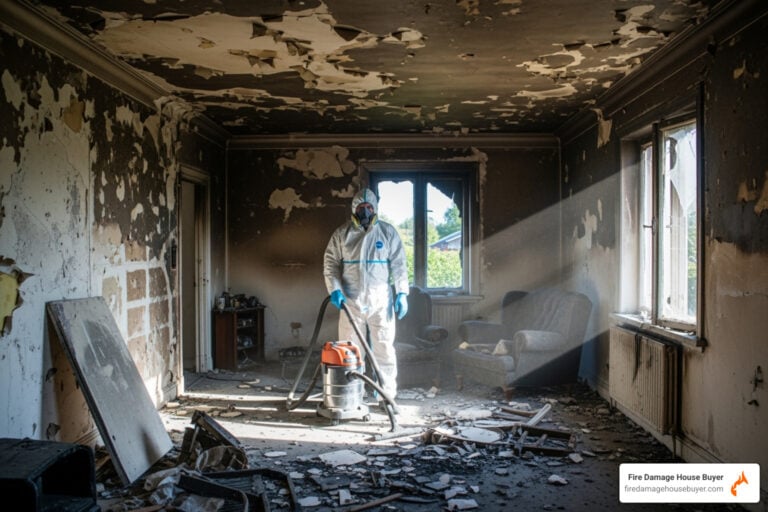The Overwhelming Reality of Fire Damage Recovery
Cleaning up after a house fire is overwhelming. The U.S. Fire Administration reports that 357,000 home structure fires occurred in 2021, causing $21.9 billion in direct property loss, leaving families to ask: What do I do now?
Essential First Steps for Fire Damage Cleanup:
- Wait for fire department clearance before entering your home
- Document all damage with photos and videos for insurance
- Contact your insurance company immediately to start your claim
- Assess what can be salvaged versus what must be discarded
- Decide between restoration or selling as-is based on damage extent
The reality is harsh: restoration costs range from $20,000 to $200,000 and can take 6-12 months. Cleaning up after a house fire involves more than removing soot; it includes structural damage, toxic residue, odors, and water damage from firefighting efforts.
You have two main paths forward: start the long, expensive journey of restoration, or sell your fire-damaged house as-is for cash and move on.
I’m Daniel Cabrera, founder of Fire Damage House Buyer. With over 16 years of experience and having handled over 275+ fire-damaged properties, I’ve helped hundreds of families steer this complex process. I know that sometimes, the smartest choice is to skip the cleanup entirely.
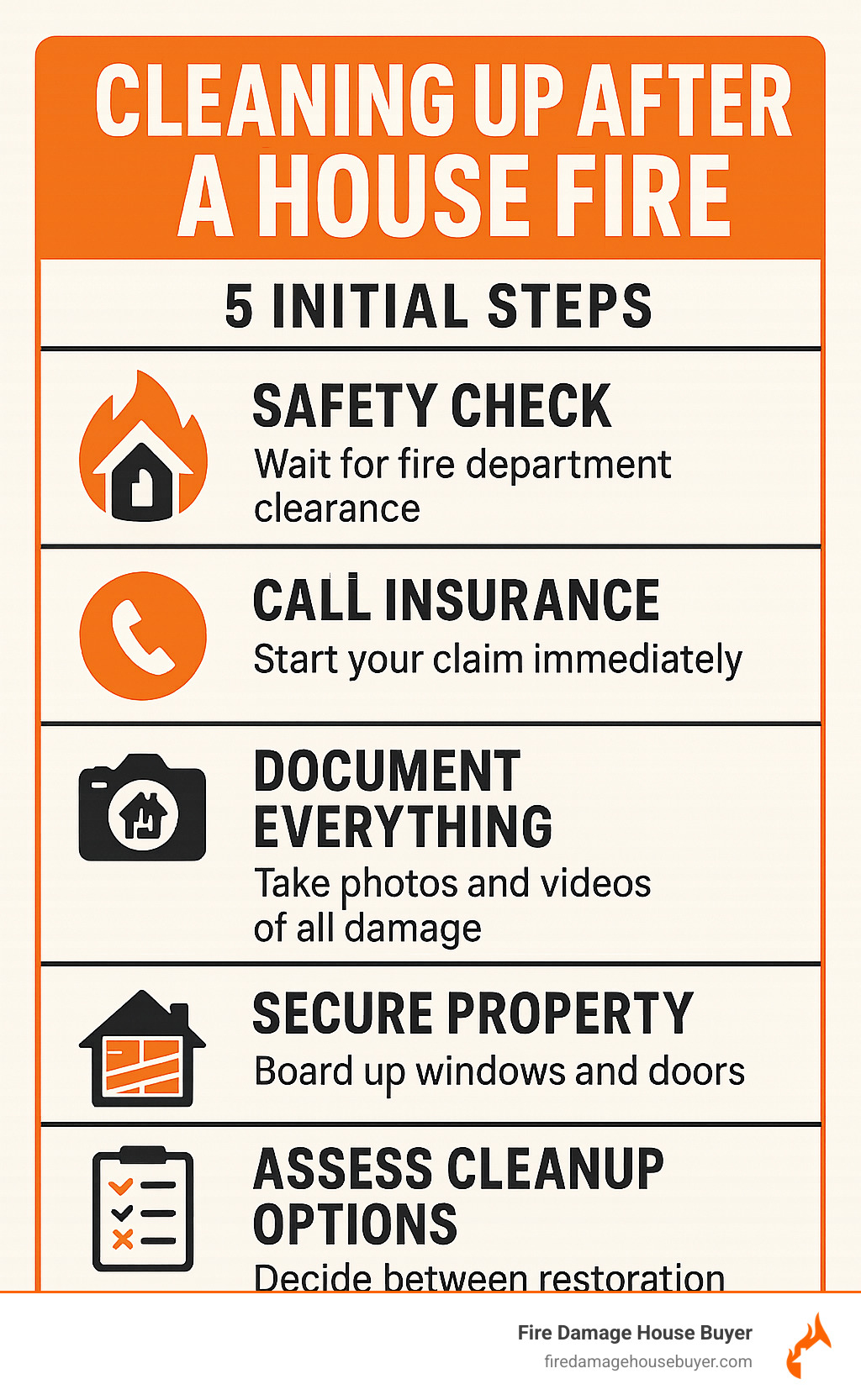
First Steps: Safety and Assessment Before You Clean
The urge to start cleaning up after a house fire is strong, but you must wait for the all-clear from the fire department first.
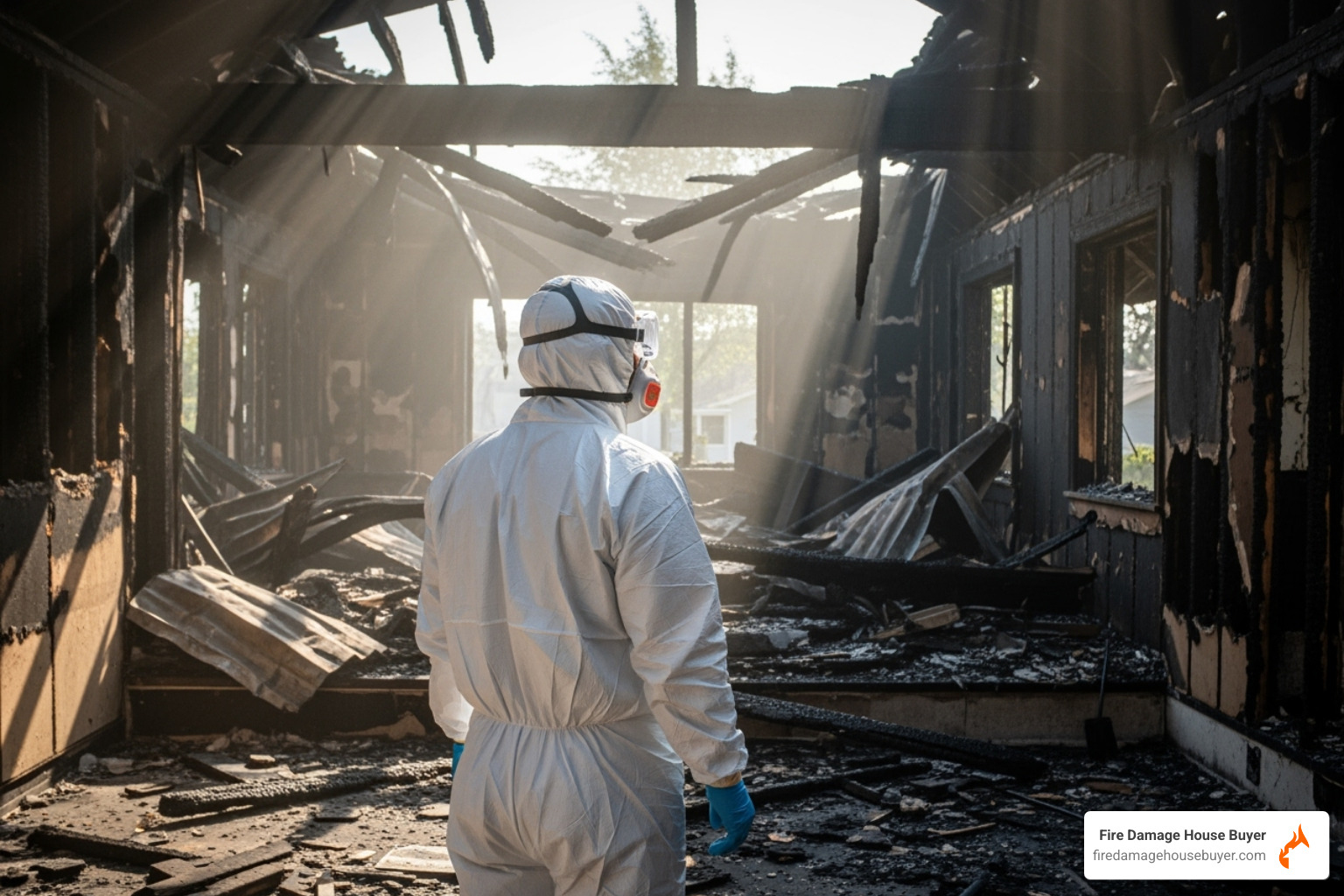
Fire department clearance is a matter of life and death. Firefighters’ emergency measures can leave your home’s structure dangerously unstable. Even after clearance, dangers remain. Electrical hazards from damaged wiring can be deadly. Never touch anything electrical. If you smell gas, evacuate immediately and call your gas company.
The health risks are as serious as the fire. Tiny soot and ash particles can penetrate your lungs, causing respiratory problems. Wet ash can burn your skin on contact.
Essential protective gear includes an N95 mask, safety goggles, long sleeves, pants, and sturdy shoes. Keep children and pets away. Follow Health and safety guidance from FEMA for comprehensive safety protocols.
Contact your insurance company immediately. Before cleaning, document all damage with photos and videos. This evidence is crucial for your claim and can save you thousands.
For a complete walkthrough of these critical first steps, check out More on the initial steps in our Checklist.
Understanding the Types of Damage
When cleaning up after a house fire, you’re dealing with multiple types of destruction:
- Fire and heat damage: This includes charred walls, melted items, and weakened structures. Even rooms without flames can suffer damage from extreme temperatures. Learn How Hot Does a House Fire Get? and how that heat travels.
- Smoke and soot damage: Microscopic particles infiltrate every surface, embedding in furniture, carpets, and walls. Oily, corrosive soot can permanently etch and stain.
- Water damage from firefighting: Thousands of gallons of water soak drywall, insulation, and flooring, leading to mold growth within 24-48 hours.
- Chemical residue: Foam and powder from fire extinguishers contaminate belongings, food, and cookware.
- Hidden structural damage: Heat and water can compromise walls, ceilings, and foundations that appear fine. A professional assessment is vital.
Addressing these damages costs $20,000 to $200,000. The true cost of cleaning up after a house fire often exceeds initial estimates.
Sorting and Disposing: What to Keep and What to Throw Away
Sorting belongings is a heartbreaking part of cleaning up after a house fire, forcing you to decide what to save and what to discard.
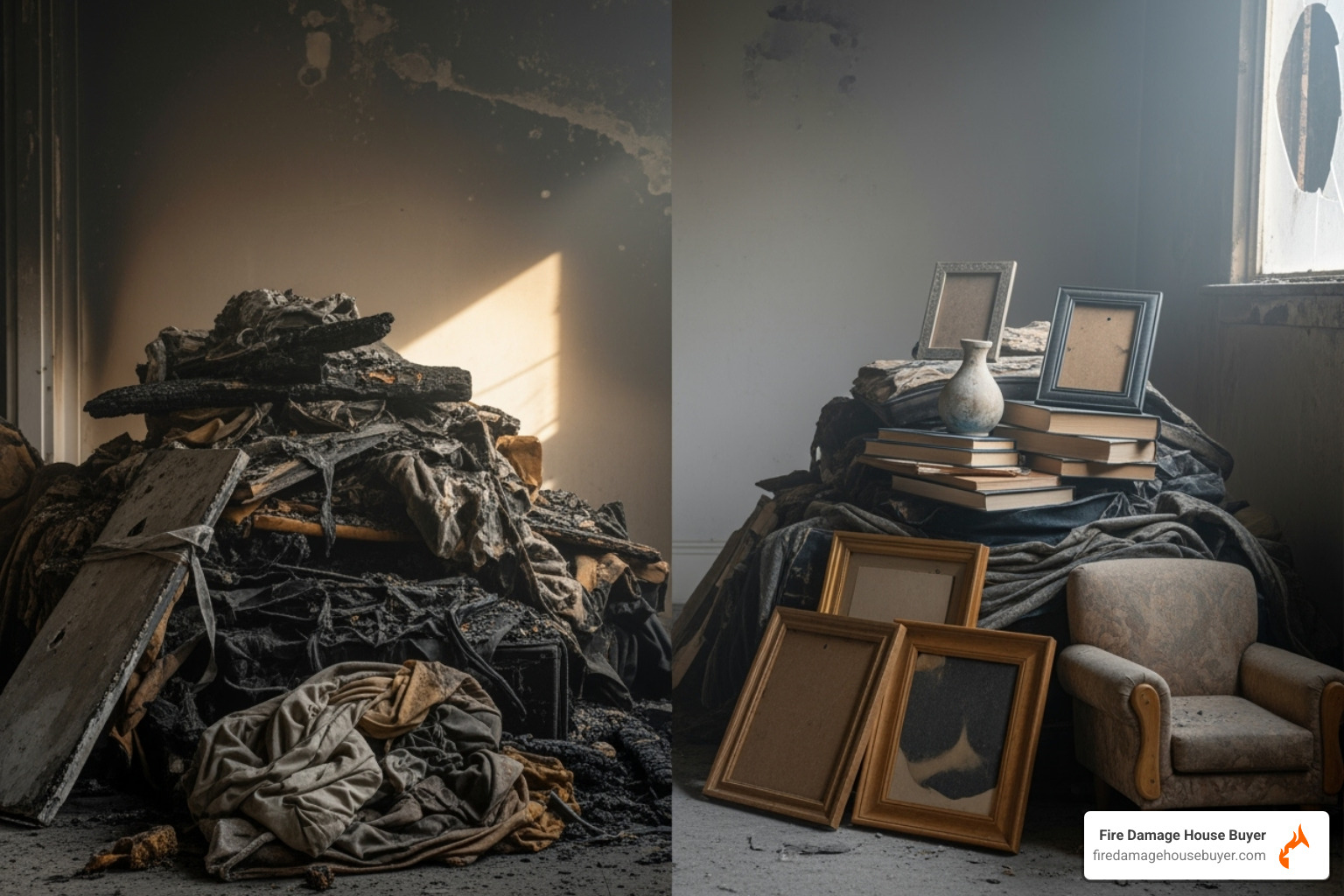
Your health comes first. The guiding principle is painful but necessary: “If in doubt, throw it out.” Contaminated items pose long-term health risks. Before discarding, create a detailed inventory for insurance with photos and videos of every item. This documentation is vital for your claim.
Here’s a general guide for what to discard:
- Food and beverages: Discard all perishable food if power was out for over four hours. Even non-perishables like canned goods can be compromised by heat and smoke; throw out anything bulged, rusted, or with damaged seals.
- Medicines and cosmetics: Must be discarded if exposed to heat or smoke, as their chemical makeup can become toxic.
- Porous materials: Items like drywall, insulation, upholstered furniture, mattresses, and carpets absorb smoke and odors and are nearly impossible to fully decontaminate. They usually must be replaced.
- Charred items: Heavily damaged clothing and furniture are typically beyond saving.
Non-porous items (metal, glass, ceramics) have a better chance. They can often be cleaned and sanitized. Uncharred hardwood can sometimes be refinished.
Electronics can have hidden internal damage from smoke and heat, creating fire or shock risks. Replacement is often the safest option. If you must save them, have an electrician inspect them first.
Replacing items is costly, but less so than the long-term health effects of keeping contaminated belongings. Restoration costs range from $20,000 to $200,000, not including replacing unsalvageable items. For more insights, see our guide on Legal and Financial Considerations After Fire.
The Ultimate Guide to Cleaning Up After a House Fire
Cleaning up after a house fire is an exhausting battle against toxins, odors, and deep-seated damage, far beyond a typical deep clean.
DIY cleaning challenges are significant. It requires specialized knowledge and equipment. Without proper training, you risk your health and could worsen the damage. The time and cost commitment is staggering, with professional restoration costing $20,000 to $200,000. DIY efforts can take months and still fail to remove odors. Honestly assess if you have the physical and emotional stamina for this task. Sometimes, recognizing that cleanup isn’t realistic is the smartest decision. Find more Practical cleaning tips for homeowners on our blog.
Recommended Cleaning Solutions and Tools for cleaning up after a house fire
- Personal Protective Equipment (PPE): Non-negotiable. Rubber gloves, N95 masks, safety glasses, sturdy shoes.
- Tri-Sodium Phosphate (TSP): A heavy-duty cleaner for soot. Mix 4-6 tbsp with 1 cup of cleaner/bleach per gallon of warm water. Follow safety instructions.
- Natural Cleaners: White vinegar and water for light damage; baking soda for odors.
- Degreasing Dish Soap: Soot is often oily.
- HEPA-Filter Vacuum: Essential for trapping microscopic soot particles.
- Sponges and Cloths: Use plenty and avoid cross-contamination.
Cleaning Walls, Ceilings, and Hard Surfaces
Start by vacuuming loose soot with a HEPA vacuum. When wet cleaning, work from the bottom up to prevent streaking. Use a TSP solution or mild detergent. Dry cleaning sponges work well on dry soot. Rinse all surfaces with clear water and dry completely. Apply an odor-blocking primer before repainting. Clean hardwood floors with oil soap; professional refinishing may be needed for charring ($3-8/sq ft).
How to Clean Clothing, Textiles, and Furniture
Vacuum soot from fabrics before wetting them. For clothing, try soaking in a vinegar or TSP solution overnight before washing. Use professional dry cleaning for delicate items or persistent odors. Upholstered furniture is difficult to clean thoroughly; replacement is often the healthier choice if odors persist. Clean non-porous furniture (wood, metal) with mild soap and water.
Sanitizing Kitchenware and Addressing Your HVAC System
Discard porous kitchen items (plastic, wood). Sanitize glass, metal, and ceramic items with a bleach solution (2 tbsp bleach per gallon of water). Your HVAC system requires professional cleaning ($300-$800) to remove circulated particles and odors. Replace all air filters immediately and then monthly for at least a year.
Even with perfect execution, DIY cleanup often falls short, and costs can spiral past $30,000.
When DIY Isn’t Enough: The Reality of Fire Damage Cleanup
After reviewing the steps for cleaning up after a house fire, feeling overwhelmed is normal. It’s a sign that this is a massive undertaking.
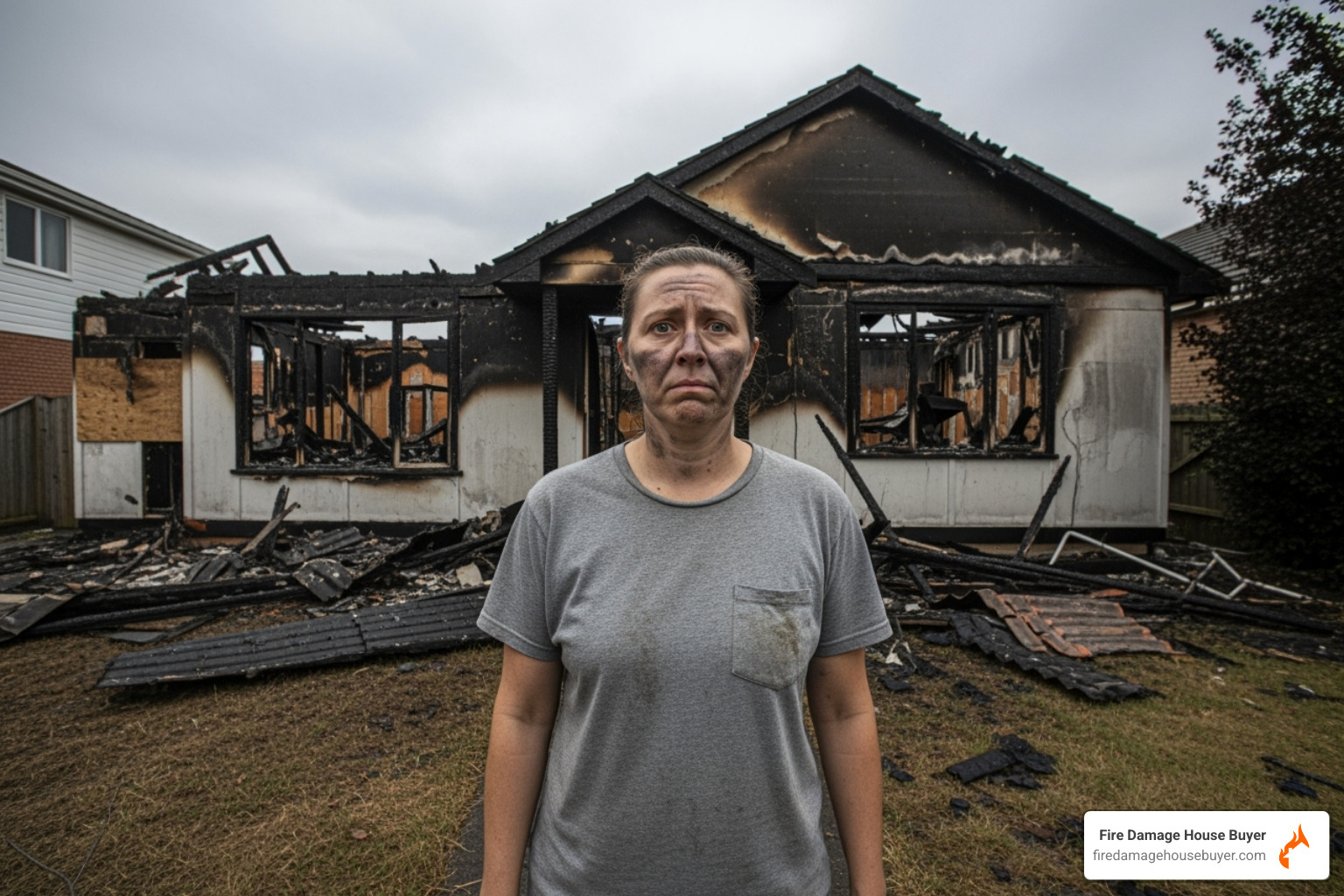
Sometimes, DIY isn’t enough. There’s no shame in recognizing when the job is too big to handle alone. Here are signs you need professional help:
- Extensive structural damage: Buckling walls, sagging ceilings, or a damaged roof require a structural engineer and can cost over $100,000.
- Widespread mold growth: If mold covers more than 10 square feet, professional remediation is essential, costing $15,000-$30,000.
- Persistent smoke odor: If scrubbing doesn’t eliminate the smell, it’s trapped deep in materials. Professional odor removal can cost $2,000-$10,000 with no guarantee of success.
- Hazardous material concerns: Older homes may contain asbestos or lead paint, requiring professional hazmat cleanup that can add $20,000-$50,000 to the bill.
The reality is that full restoration costs range from $20,000 to $200,000 and take 6-12 months or more. This means a year of your life managing contractors, insurance, and living in temporary housing. Costs often spiral, and the emotional toll of the uncertainty can be devastating.
For more information about the professional restoration process, you can Find out more about Fire Damage Restoration.
The question isn’t if your home can be restored, but if it should be, given your finances and timeline.
The Simple Solution: Selling Your House As-Is for Cash
After learning about cleaning up after a house fire, it’s understandable to feel overwhelmed. Restoration is a long, stressful process with costs ranging from $50,000 to $200,000.
The stress involves coordinating contractors, managing permits, and making endless decisions, often from temporary housing while costs mount. But there’s another option: you don’t have to go through any of that.
At Fire Damage House Buyer, we offer a different path. You can sell your house to us as-is—soot, water damage, and all—and skip the year-long restoration project. This means no cleaning, no repairs, and no contractors. You don’t have to lift a finger.
We charge no commissions or fees and cover all closing costs. We can close in just a few days, putting cash in your hands so you can move on. We operate nationwide and our process is designed to be stress-free. We understand you’ve been through enough.
This is about choosing the best path for your family’s future. Often, the smartest move is to take the insurance settlement, add our cash offer, and start fresh. Learn How It Works and see how simple our process is.
Don’t just take our word for it – Read our Reviews to hear from other homeowners who chose this path and found peace of mind.
Frequently Asked Questions about Cleaning Up After a House Fire
Here are answers to common questions homeowners have after a fire.
How long does it take to get the smoke smell out of a house?
Eliminating smoke odor after cleaning up after a house fire is complex. For minor damage, it can take weeks or months of DIY effort. Smoke particles embed deep into porous materials like wood and drywall and can linger indefinitely. Professional odor removal costs $3,000 to $15,000 and can take weeks, with no guarantee of complete success.
Is it safe to stay in a house with smoke damage?
No, it is not safe. Smoke and soot residue contain toxic chemicals like carbon monoxide and hydrogen cyanide, which can cause serious health problems, especially for those with asthma or allergies. These particles circulate through your HVAC system. Always wait for professional air quality testing before moving back in. The high cost of temporary housing ($100-$200 per day) is another reason many choose to sell as-is.
What should I throw away after a small kitchen fire?
Even a small kitchen fire requires careful cleanup. For safety, discard the following:
- All open food containers and any perishables exposed to heat or fumes.
- Canned goods that are warped, bulged, or damaged.
- Porous utensils (plastic, wood) that absorb smoke and chemicals.
- Small appliances, which can have hidden internal damage and pose a future fire risk.
After discarding items, all surfaces must be thoroughly cleaned. The total cost for cleanup and replacement after a small kitchen fire can still be $2,000 to $8,000. Selling as-is can be a smarter financial decision.
Conclusion
Cleaning up after a house fire is a monumentally difficult process of rebuilding your life. It’s far more than just a cleaning project. You’re facing months of restoration, costs from $50,000 to $200,000, and immense emotional strain. Every day spent on this project is a day you can’t move forward.
The restoration route is complex, involving contractors, insurance adjusters, and living in limbo. This path works for some, but it requires significant time, money, and emotional energy.
The other path is selling your fire-damaged house as-is for cash. This is a smart financial and emotional decision that puts you back in control immediately.
At Fire Damage House Buyer, we buy your house as-is—damage and all. We offer a simple solution: no repairs, no commissions, and no lengthy closing process. You get a fair cash offer and the freedom to start fresh.
The choice is personal. If restoration feels overwhelming or financially unfeasible, we offer a simpler solution.
Contact Us for a no-obligation offer and find out how quickly you can turn this chapter of your life and move toward a brighter future. For additional resources, Explore our Blog for more resources where we share practical advice from families who’ve walked this path.

